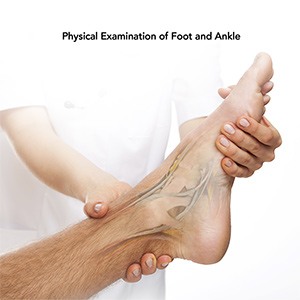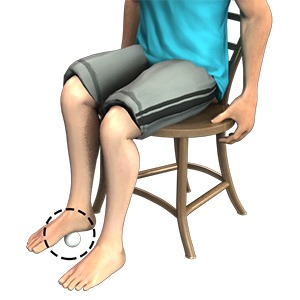- Foot and Ankle Anatomy
- Foot and Ankle Conditions
- Foot and Ankle Procedures
Minimally Invasive Bunion Surgery

Minimally invasive bunion surgery, also known as keyhole bunion surgery, is a procedure to treat a foot condition called a bunion or hallux valgus. During minimally invasive bunion surgery, a few small incisions are made to access the bone around the bunion, as opposed to a much larger incision made during an open bunion surgery...
Toe Deformity Correction

Toe deformity correction refers to nonsurgical and surgical measures employed in the treatment of toe deformities. Toe deformity is a condition where there is a misalignment of the toe bones. Common toe deformities include hammertoe, claw toe, and mallet toe. Toe deformities can be present at birth or can occur later in life from wearing improperly fitted shoes or high-heeled shoes.
Flatfoot Reconstruction

Foot reconstruction is a surgery performed to correct the structures of the foot and restore the natural functionality of the foot that has been lost due to injury or illness. Flatfoot or pes planus is a condition in which the foot does not have a normal arch when standing. The primary objectives of flatfoot reconstruction are reduction of pain and restoration of function and appearance.
Charcot Foot Reconstruction

Charcot foot reconstruction is a surgery performed to repair damage to the bones, ligaments, tendons and other structures in a foot affected by a condition called Charcot foot, which is characterized by loss of sensation in the foot. Charcot foot also called “neuropathic osteoarthropathy”, is a serious condition that can result in severe infection, deformity, and disability.
Achilles Tendon Repair

Tendons are the soft tissues connecting muscle to bone. The Achilles tendon is the longest tendon in the body and is present behind the ankle, joining the calf muscles with the heel bone. Contraction of the calf muscles tightens the Achilles tendon and pulls the heel, enabling the foot and toe movements necessary for walking, running and jumping.
Ankle Instability Surgery

Ankle instability is a chronic condition characterized by the recurrent slipping of the outer side of the ankle. Instability is generally noticed during movement of the ankle joint, but can also occur while standing. Ankle instability usually results from repeated ankle sprains. Inadequate healing of a sprained ligament or incomplete rehabilitation of the affected ligament can result in instability.
Ankle Ligament Reconstruction

Ankle ligament reconstruction is a surgical procedure typically performed to treat serious sprains or instability in the ankle. An ankle sprain is a common injury that occurs when the ankle is turned or twisted, and results in torn ligaments within the joint. The ligaments in your foot and ankle consist of the anterior talofibular ligament (ATFL) and the calcaneofibular ligament (CFL).
Ankle Joint Replacement

Ankle joint replacement, also known as total ankle arthroplasty, is a surgical procedure performed to relieve pain and immobility due to severe end-stage arthritis that has not responded to non-surgical treatments. The goal of ankle joint replacement surgery is to eliminate your pain and increase the mobility of your ankle joint.
Ankle Fusion

Ankle fusion, also known as ankle arthrodesis, is a surgical procedure commonly employed for the treatment of ankle arthritis in which the joint cartilage is severely damaged. The procedure involves fusion of the bones that form the ankle joint into one piece, which eliminates joint motion and relieves pain originating from the arthritic joint.
Foot and Ankle Surgery

Foot and ankle surgery is a specialized field of orthopedic surgery that focuses on the diagnosis, treatment, and prevention of disorders affecting the foot and ankle. Foot and ankle surgery aims to relieve pain, restore function, and improve the overall quality of life for patients with foot and ankle disorders.
Minimally Invasive Foot Surgery

Minimally invasive foot surgery (MIFS) uses the latest advanced technology to treat foot and ankle pain caused by a variety of conditions. Special surgical instruments, devices, and advanced imaging techniques are used to visualize and perform the surgery through small incisions.
Total Ankle Replacement

Total ankle replacement, also known as total ankle arthroplasty, is a surgical procedure designed to relieve pain and restore function in patients with severe ankle arthritis or damage. It involves replacing the diseased or damaged ankle joint with an artificial implant (prosthesis).
Ankle Arthroscopy

Ankle arthroscopy is a minimally invasive surgical procedure in which an arthroscope, a small, soft, flexible tube with a light and video camera at the end, is inserted into the ankle joint to evaluate and treat a variety of conditions. The camera projects an image of the inside of the joint onto a large monitor, allowing your surgeon to look for any damage...
Foot and Ankle Osteotomy

Foot and ankle osteotomy is a surgery performed to remove parts of a bone in your foot or ankle that might be causing pain or limiting your mobility. The surgery helps relieve pressure on the foot and ankle caused by the bone deformity or injury. The foot and ankle consist of 26 bones, 33 joints, and many muscles, tendons, and ligaments.
Hammertoe Surgery

Hammertoe is a foot deformity in which one or more toes bend downward at the middle joint, often due to muscle imbalance, tight shoes, arthritis, or genetics. It can cause pain, corns, calluses, and difficulty walking. Hammertoe surgery is a procedure to correct this deformity and restore normal toe function.
Foot Reconstruction

Foot reconstruction is a surgery performed to correct the structures of the foot and restore the natural functionality of the foot that has been lost due to injury or illness. Ideally, any foot surgery for reconstruction is done to improve the appearance and function of the foot so that you can maintain your quality of life.
Charcot Reconstruction

Charcot foot and ankle is a condition characterized by gradual weakening of the bones, joints and soft tissues, and loss of sensation in the foot and ankle. It is caused by nerve damage (neuropathy) in the foot and ankle or due to diabetes. Charcot reconstruction is the surgical procedure of repairing and restoring the foot and ankle.
Cavovarus Foot Correction

To support the entire body’s weight on your two feet, the inner middle portion of each foot (midfoot) is raised off the ground to form an arch. A cavovarus foot deformity is characterized by a higher-than-normal arch of the inner midfoot. This results as the two ends of the foot - the heel and toes - abnormally draw towards the inside of the foot, causing the foot to rest on its outer side.
Bunionette Surgery

A bunionette, commonly known as a tailor’s bunion, is a bony lump on the outside of the base of the little toe. This is generally caused by the shift or enlargement of the joint connecting the fifth metatarsal bone on the outside of the foot to the base of the little toe. In some cases, this may be caused by the formation of a bone spur along the fifth metatarsal bone head.
Lesser Toe Surgery

Lesser toe surgery is an operation to correct deformities of the lesser toes other than the big toe. Some of the common lesser toe deformities include hammer toe, claw toe, and mallet toe. Anatomically, the foot is divided into the forefoot, mid foot and hind foot. The forefoot has 4 small toes called phalanges and 1 large toe called the hallux or big toe.
Bunionectomy

A bunionectomy is a surgical procedure to remove a bunion. A bunion, also called a hallux valgus, is an enlargement of bone or soft tissues around the joint at the base of the big toe that results in the formation of a bump. The bone that joins the big toe with the first metatarsal bone thickens and enlarges, tightening the tendons...
Plantar Fascia Release

Plantar fascia release is a surgical procedure to treat moderate to severe plantar fasciitis, in which your surgeon releases or removes the diseased section of the plantar fascia tissue to relieve pain and inflammation in the foot. Plantar fasciitis is a condition where the plantar fascia becomes inflamed from overstretching or overuse, causing pain in the heel and bottom of the foot.
Foot Tendon Repair

Foot tendon repair is a surgical procedure aimed at restoring function and stability to a damaged or ruptured tendon in the foot. Tendons are strong, fibrous tissues that connect muscles to bones and are essential for movement and stability. Tendon tears can result from trauma, overuse, or degenerative conditions and may require surgical intervention to restore function.
Big Toe Arthroscopy

Big toe arthroscopy is a minimally invasive surgical procedure in which an arthroscope - a thin telescope-like instrument with a light and video camera on the end - is inserted into the big toe to evaluate and treat a variety of conditions. The camera projects an image of the inside of the big toe onto a large monitor, allowing your surgeon to look for any damage...
Foot and Ankle Examination

Foot and Ankle conditions typically occur due to injury of the muscles, ligaments or bones, due to aging, or certain disorders including gout, bunion, arthritis, claw toes, bursitis, hammertoes, stress fracture, etc. Examination of the foot and ankle is necessary for an accurate diagnosis of injury or disorder.
Big Toe Motion Preservation Surgery

Big toe motion preservation surgery is a procedure employed for the treatment of a stiff big toe. A stiff big toe, also called hallux rigidus, is a form of degenerative arthritis affecting the joint where the big toe (hallux) attaches to the foot. The toe typically becomes stiff at the base and is sometimes called a “frozen joint”.
Cavus Foot Reconstruction

Cavus foot reconstruction is a deformity correction surgery to treat cavus foot which is also called pes cavus or high arches. Cavus foot occurs when the arch on the bottom of the foot that runs from the toes to the heel is arched more than normal. This causes pain and instability in the foot while walking, standing, and running.
Foot and Ankle Cartilage Repair

Foot and ankle cartilage repair is a surgical procedure to restore the damaged cartilage in the foot and ankle joint. Cartilage repair can be performed either through a single long incision called the open approach or via a minimally invasive approach called arthroscopy.
Foot & Ankle Deformity Correction

Foot and ankle deformity is the structural abnormality caused by misalignment of the bones of the foot and ankle. Foot and Ankle deformity correction is the repair of the abnormality by restoring the normal alignment of the bones in the foot & ankle, surgically or non-surgically.
Foot and Ankle Rehabilitation

The foot is composed of different structures including bones, ligaments, tendons, and muscles. As the feet bear the weight of our body, they are more prone to injury and pain. A foot injury or foot surgery may leave you immobile for a period of time. After any injury or surgery to your foot, a rehabilitation program will help you get back to your daily activities quicker.
Diabetic Wound Management

Diabetic wound management is the process of treating wounds complicated by diabetes. Diabetes is a chronic condition characterized by high blood glucose (sugar) levels. Diabetic patients are at a higher risk for developing chronic wounds on the limbs, especially in the feet. The most common type of diabetic wound is an ulcer or open sore in the sole of the foot.

